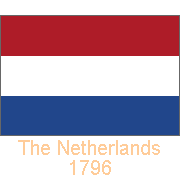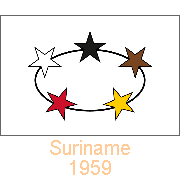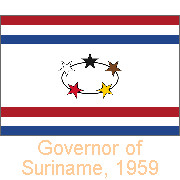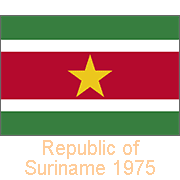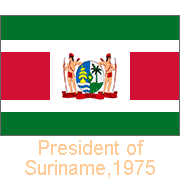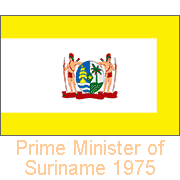Flags from Suriname
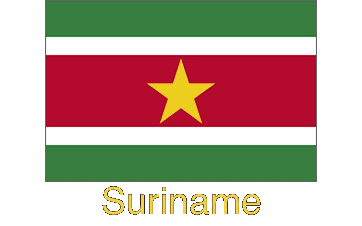
A Flag history of Suriname
Suriname was a colony of the Netherlands from 1667. It used the Dutch flag, the oldest Republican tricolour in the world, initially the Prinsenvlag (orange-white-blue), introduced in the struggle against the Spanish under leadership of the Prince of Oranje Nassau in 1579. The red-white-blue version was officially established on 14 February 1796, supposedly because "the colour red was better visible at sea".
you may then send it as a postcard if you wish.
In 1954, Suriname became one of the constituent countries of the Kingdom of the Netherlands and in 1959 a flag was adopted. On a white field five coloured stars represent Suriname's major ethnic groups: the original Amerindians, the colonising Europeans, the Africans brought in as slaves to work in plantations and the East Indians, Javanese and Chinese who came as indentured workers after the abolition of slavery. The ellipse represents the harmonious relationship amongst the groups. At the same time a flag for the Governor of Suriname was adopted, based on the National flag, with two red-white-blue bands, representing the flag of the Netherlands, at top and bottom.
Upon independence, 25 November 1975, Suriname adopted a new flag. It consisted of five unequal horizontal bands of green, white, red, white, and green, with a large, yellow, five-pointed star centred in the red band. The star represents the unity of all ethnic groups, its yellow colour symbolising the sacrifices made, the red stripe stands for progress and love, the green for hope and fertility of the nation, and the white bands for peace and justice.
The Presidential Standard is based on the National flag of Suriname, but, superimposed on it, a white panel with the state arms: a shield displaying a Dutch sailing ship (representing commerce), a palm tree (representing agriculture) and a diamond (representing mining) with the yellow star, representing the unity of all ethnic groups. it is supported by two Amerindians in traditional attire. On a scroll is the National motto, in Latin, "Justitia, Pietas, Fides" (Justice, Piety, Faith). The arms dates back to the 17th century and the time of Dutch rule, but was revised in 1959 and again 1975. A Standard of the Prime Minister of Suriname was introduced as well, but became obsolete in 1988 when the position of Prime Minister was abolished and replaced by that of a Vice President. It featured the state arms on a white field, with a broad yellow border on three sides.


